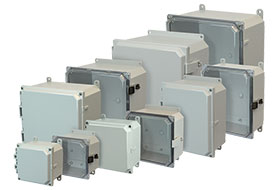When you use an electrical enclosure, you can only put so many things inside of it before you exceed electrical code, and that can be a major problem.
It’s important to know how to fill a box according to ratings. This guide will show you the easiest way to calculate box volumes and ratings to stay within regulations. Regardless of the enclosure accessories and devices, you can follow this guide for quick success.
Box Ratings
Every electrical enclosure is rated by the manufacturer. This rating tells you specifically what the non-metallic boxes can hold, and those specifications depend on the gauge of wire you use. As an example, a box could have a rating of 7/10, 8/12, 9/14.
These numbers show you the volume allowances (explained in the next section) for varying wire gauges. As you can see, smaller gauges allow for more volume allowances because they take up less space in the box.
Many electrical enclosures have their ratings printed right on the box, but when that isn’t the case, you can find these ratings in the enclosure literature from the manufacturer.
Volume Allowances
The ratings give you the volume allowances, but you need to know how to use these numbers. The second number in the rating is the wire gauge. Depending on that gauge, you get a different number of volume allowances.
Adjustable electrical boxes can hold wires and devices up to that numerical limit and still be up to code, but the way you count volume allowances follows a handful of rules:
● Each gauge wire counts as one volume allowance. For instance, a standard cable has a hot and neutral wire. That means the cable counts for two volume allowances (ground wires have their own rule).
● If you have four or fewer grounds in the box, that counts as one volume allowance. Each ground above four counts as 0.25 volume allowances. For example, one ground is 1 allowance, four grounds is 1 allowance, but six grounds is 1.5 allowances.
● Each yoke or strap counts as one allowance. An outlet that connects at two points would count as two allowances.
● All of the internal clamps combined count as just one volume allowance.
● Knockouts do not count as volume allowances.
Using those rules, you can add up the volume allowances in your configuration. If they are equal to or less than the rating for the enclosure, you’re good.
Cubic Inches
Cubic inches also matter. In fact, box ratings are derived from cubic inch considerations. Electrical code limits how much you can put in an enclosure to prevent overcrowding.
So, volume allowances are really just a fast way to calculate cubic inches, but sometimes, you won’t have a volume allowance rating. Instead, you only get a cubic inch rating. Fortunately, it’s easy to convert from one to another.
To figure out how many cubic inches are used by your configuration, count up the volume allowances that it uses. Then, multiply them by the conversion factor in the table below.
A Quick Example
Let’s do a quick example to show how this works. Say you use 14-gauge wire to attach an outlet in a single-gang box with no clamps. You will have two wires into the box (one for each plug in the outlet).
This means you will use four allowances for the hot and neutral wires, one allowance for the two grounds, and two allowances to connect the outlet.
4 (wire) + 1 (ground) + 2 (outlet) = 7 allowances.
If your box rating is 7/14 or larger, you’re good.
Now, let’s see what that looks like in cubic inches.
Using the table, we can see that the conversion for 14-gauge is 2.00. All we do is take the allowances and multiply by two to see how many cubic inches we are using.
7 allowances X 2.00 = 14.00 cubic inches.
If the box is rated for 14.00 cubic inches or more, then this configuration is up to code.
Source Url: - https://sites.google.com/view/alliedmoulded87/home





Comments